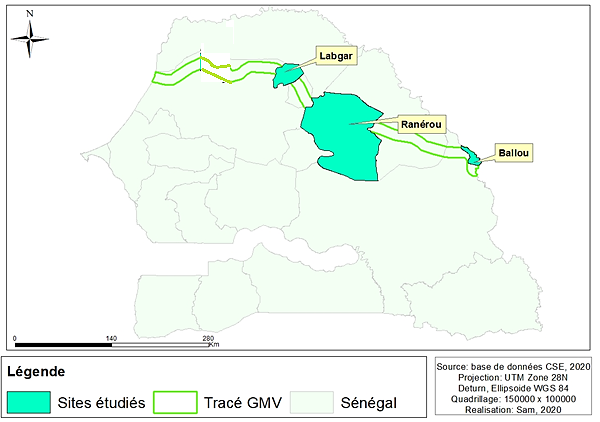Étude du potentiel de stock de carbone chez cinq espèces sahéliennes au Ferlo : (Acacia seyal Del., Acacia nilotica (L.), Combretum glutinosum perr. ex DCC, Commiphora africana (A. Rich.) et Pterocarpus lucens Guill. & Perr).
Study of the carbon stock potential in five Sahelian species in the Ferlo: (Acacia seyal Del., Acacia nilotica (L.), Combretum glutinosum perr. ex DCC, Commiphora africana (A. Rich.) and Pterocarpus lucens Guill. & Perr).
2022
OHM Project
Tessekere OHMi

Leader : Talla Ramata
Project leader’s laboratory : Laboratoire d'Ecologie végétale et Ecohydrologie
Full address of laboratory : Université Cheikh Anta Diop de Dakar (UCAD) Dakar Sénégal B.P. 5005 Dakar-Fann
Coauthor(s) : Ramata TALLA, Moustapha Bassimbé SAGNA, Aly DIALLO, Aliou GUISSE
Keywords :
Biomasse
Carbone
équation allométrique
Ferlo
GMV
Disciplines :
Biologie
Climatologie
Ecologie
Abstract :
Le bilan du carbone est élaboré pour engager des réflexions sur la démarche de gestion environnementale vis-à-vis de la problématique liée à la maîtrise de l’énergie et des stratégies à mettre en œuvre pour la réduction des émissions de gaz à effet de serre (IPCC, 2003). L’objectif de cette étude est de contribuer à l’évaluation du stock de carbone par les espèces ligneuses du Ferlo.
L’étude sera effectuée au Ferlo (Nord du Sénégal), compte tenu de la densité de chacune des espèces sur le tronçon sénégalais de la GMV, trois sites sont retenus pour cette étude, situés sur l’axe Labgar - Ballou (figure 1).
- Labgar, pour l’étude des populations de Commiphora africana (A. Rich.)
- Ranérou, pour l’étude des populations de Combretum glutinosum perr. ex DC et de Pterocarpus lucens Guill. & Perr
- Et Ballou pour l’étude des populations de Acacia seyal Del., et de Acacia nilotica.
Les individus choisis feront l’objet de caractérisation dendrométriques avant d’être coupés, compartimentés (tronc, branches, rameaux et brindilles-feuilles) et pesés entièrement. Au laboratoire les échantillons prélevés seront séchés à l’étuve jusqu’à poids constant afin de déterminer le taux d’humidité pour estimer la biomasse sèche de chaque arbre.
Des tests de régressions simples seront effectués pour examiner le paramètre dendrométrique (x) le plus explicatif de la biomasse (y) des espèces.
Ces résultats peuvent être utilisés pour une étude de l’évaluation du carbone séquestré et jouera un rôle dans le suivi du marché du carbone en Afrique.
Translated abstract :
The carbon balance is elaborated to initiate reflections on the environmental management approach in relation to the problem of energy control and strategies to be implemented for the reduction of greenhouse gas emissions (IPCC, 2003). The objective of this study is to contribute to the evaluation of the carbon stock by woody species in the Ferlo.
The study will be carried out in the Ferlo (northern Senegal), taking into account the density of each of the species on the Senegalese section of the GMA, three sites are selected for this study, located on the Labgar - Ballou axis (Figure 1).
- Labgar, for the study of Commiphora africana (A. Rich.) populations
- Ranérou, for the study of the populations of Combretum glutinosum perr. ex DC and Pterocarpus lucens Guill. & Perr
- And Ballou for the study of the populations of Acacia seyal Del. and Acacia nilotica.
The selected individuals will be dendrometrically characterized before being cut, compartmentalized (trunk, branches, twigs and leafy branches) and weighed entirely. In the laboratory, the samples will be oven dried to constant weight to determine the moisture content to estimate the dry biomass of each tree.
Simple regression tests will be performed to examine the dendrometric parameter (x) that best explains the biomass (y) of the species.
These results can be used for a sequestered carbon valuation study and will play a role in monitoring the carbon market in Africa.

